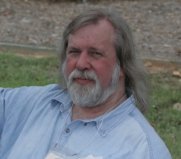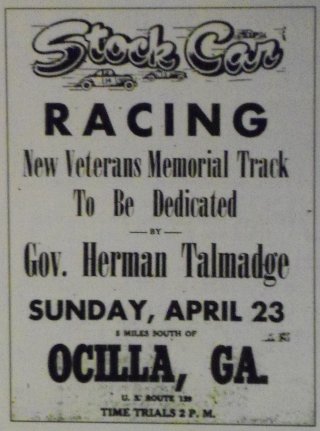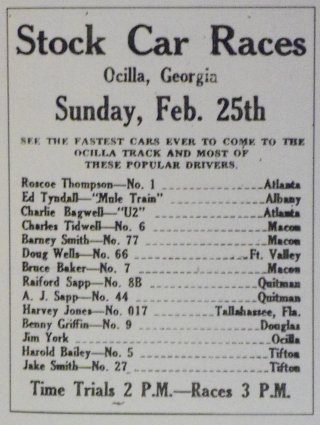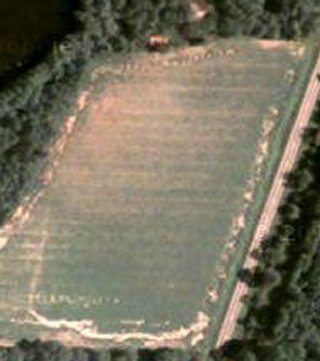
Mike Bell
By Mike Bell
Posted in Columns 11/18/11
In the beginning of our research on the old days of racing, I found the library at the University of Georgia. I can’t remember who told me about it, but it was either Joe Cawley or Eddie Samples.
Eddie actually accompanied me on the first trip there. He wouldn’t make that mistake again. We stayed for hours. In the basement of that library were microfilms of almost every newspaper printed in the state of Georgia. I’ve been told that the only place with more is the Georgia State Archives, which is now located south of Atlanta near Ellenwood.
One of the things I wanted to do was go through the newspapers of the major cities of Georgia from WWII to 1958. While researching Savannah, I found when Oglethorpe Speedway first opened (motorcycle in March of 1951). Then there was an ad for races in Waycross a few months later. At a later date while researching Waycross, I came across references to racing in Douglas and Ocilla. The Douglas site is now the location of the Douglas Motorsports Park.
But the Ocilla track was what intrigued me. Why Ocilla?

Newspaper ad for the opening of the Ocilla Speedway on April 23, 1950. Courtesy Mike Bell
Even after I found articles in the local Ocilla paper, I could not find my answer. I did find that the track was run by the American Legion there and that Governor Herman Talmadge was to attend the first race. Not only did this not answer my original question, but instead it gave me more questions.
Then along came Jimmy Alexander. He joined us in the early days and had been wondering what he could do to help. With him being from nearby Fitzgerald, Georgia, I figured he might know about the track in Ocilla.
I opened a floodgate. When I questioned Georgia Racing Hall of Famer Eddie MacDonald’s grandson about Jimmy, he smiled and said, “Yeah, he’s for real and he knows everybody.”
Before the annual picnic in Tifton, Georgia in 2007, I agreed to meet with Jimmy at “the” BBQ place in Ocilla, where the two main highways cross. We even met a gentleman, Fred Hester, who knew where Turner County Speedway was, but that’s another story.
We met so many people, it all became a blur until Jimmy and I rode out of town on US Highway 129 towards Alapaha. About five miles out, he tells me to turn off the road where there is a big curve to the right.
Sitting there in his pickup was Buddy Green, son of the later track owner, Marion “Buddy” Green, Sr. We stopped next to a newly plowed field that has a couple of acres in the middle with an overgrowth of trees and such.
I found out from Buddy that there are three ponds in all that overgrowth and has been for as long as he can remember.
Buddy told us that his father bought the property in 1932 and built a store where we had turned off the highway at the big curve. The DOT (or whatever it was called in those days) then built a new bridge just beyond the property and changed the road (adding the big curve). You can still see the concrete island for the gas pumps.
His family opened the store in 1936 and lived in the store for several years. I found that this was a very common occurrence in the “good old days”.
In 1940, the Green family moved into a new home right down the road from the store. That house still stands but has been moved back on the same property near another small lake.
Mr. Green bladed out the track himself and it was probably about a 3/8-mile layout. Buddy remembered a big board fence that was built next to the road to keep folks from stopping and watching the races for fee.

A later ad for the Ocilla track, touting some of the drivers expected to compete. Courtesy Mike Bell
How does he remember? With gallons of red paint and a brush provided by his father. Buddy painted that fence. In the small home that sits on the edge of the plowed field, there are rafters in the ceiling that still have that same red paint on them.
The wood for the grandstands, fence and judge’s stand all came from Mr. Green’s pulpwood venture, which he worked as well as the store during the war.
Mr. Green also dabbled in politics and was the local representative to the state legislature about the time of the track’s inauguration. Buddy even remembered being a page for the local paper for about two weeks when he was 12, and he even sat on Governor Herman Talmadge’s knee once. A legislator’s son had perks.
The “New Veterans Memorial Track” was dedicated on April 23, 1950. Governor Herman Talmadge was to attend the ceremonies and races. But Herman was a no-show and former Governor M.E. Thompson came in his place.
Still some 2500 spectators watched a five-race program that was topped off with James Bennett of Macon winning the 20-lap feature. He was followed by Billy Sawyer, Roy Bentley, Barney Smith and the ill-fated Bunk Ezzell, who died later in a fiery crash at the Warner Robins Speedway. Believe it or not, there was a women’s race won by Mr. Lucy Stacks of Fitzgerald.
Buddy says that his father ran a few more races before turning the reins over to the VFW because there was a bad wreck at the track. No one was killed but his father could see the vast liabilities taking away everything he owned.

A look at the site of the Ocilla Speedway as it sits today.
Races ran about every three weeks until early December. They started again in January of 1951. For the races in February, they advertised drivers from as far away at Atlanta (Roscoe Thompson) and Tallahassee, FL (Harvey Jones) with one hometown hopeful in Jim York.
But when the dust cleared, “Big John” Hutto of Fort Valley had won the feature with Doug Wells of Atlanta almost coming in second (expense of a blown tire). Harvey Jones ran second to Hutton in a special fast car dash with the six fastest qualifiers.
Later in the year, several ads ran a list of expected entries with Coot Rowland of Valdosta being one, as well as the famous Sapp brothers, Rayford and A.J., out of Quitman, Georgia, along with Leland Fowler of Cordele, Nero Steptoe (then racing out of his hometown of Albany) and some Jacksonville, FL drivers.
On the day I visited the site of the track, Buddy drove me around what used to be the track surface. In among all the South Georgia black dirt, you could still see the red clay that was used for the speedway. The ponds are still there as well.
Buddy’s pride really showed for the accomplishments of his father, and well it should. Mr. Green had carved out his own track on his own property and had drivers coming from all over South Georgia and north Florida to race. And you could see it all for a buck.
Toss in an extra two bits, and you got a reserved seat.
Editor’s note: This story originally appeared in the March 2007 edition of the Pioneer Pages magazine.
Mike Bell is the CEO and historian for the Georgia Auto Racing Hall of Fame Association, Inc. (GARHOFA)
Questions, comments, suggestions? Email us!
This website is not affiliated with or endorsed by the Georgia Racing Hall of Fame or the Georgia Auto Racing Hall of Fame Association, Inc. All content is the intellectual property of the individual authors. All opinions are those of the individual authors. Please do not repost images or text without permission.
